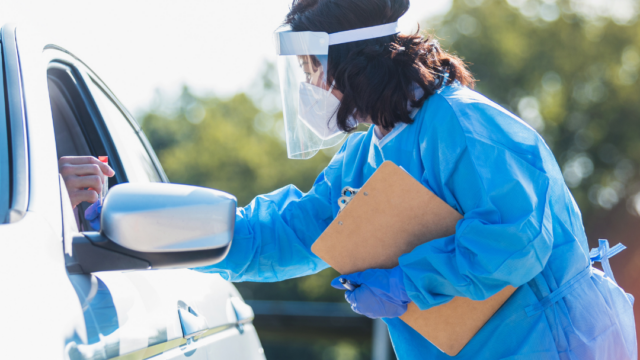Frontline Blog
Joint Statement of Support on Transition Away from Case Investigation and Contact Tracing
January 2022

The Association of State and Territorial Health Officials (ASTHO), Council of State and Territorial Epidemiologists (CSTE), National Association of County and City Health Officials (NACCHO), Big Cities Health Coalition (BCHC), and Association of Public Health Laboratories (APHL) support state, local, territorial, and tribal health departments in transitioning away from universal case investigation and contact tracing at this point in the COVID-19 pandemic to a more strategic approach of outbreak investigations and targeted case investigations. Although universal case investigation and contact tracing was implemented in spring 2020 to slow COVID-19 transmission, much has changed over the past year prompting the need for a revised public health approach. This includes the wide availability of safe and effective vaccines, better understanding of the epidemiology of the SARS-CoV-2 virus, and the emergence of the more infectious Omicron variant.
While universal case investigation and contact tracing during the initial phase of the pandemic was justified in the attempt to contain the pandemic, most experts in public health agree this is no longer optimal. Many states and localities have already scaled back or stopped universal case investigation and contact tracing for COVID-19. We urge a refocus of our public health efforts and resources, with an emphasis on targeting investigations in higher risk settings serving vulnerable populations and other critical measures to better protect the public’s health.
A number of scientific and other factors reduce the utility and feasibility of universal case investigation and contact tracing for each COVID-19 case. These factors include:
- The large number of asymptomatic and less severe cases. This is due to changes in the virus and widespread vaccination in the U.S.
- Many infections are never identified by public health agencies because persons with asymptomatic or mild cases may not get tested, as well as the increasing use of “over the counter” at-home tests, which are generally not reported to public health agencies
- The highest risk of transmission to others occurring prior to symptom onset and during the first few days of symptomatic illness (or immediately after first testing positive for those who remain asymptomatic)
- The shorter incubation period of the Omicron variant
Consequently, only a very small portion of total cases and close contacts are being reached by public health contact tracers in time to prevent onward transmission.
Therefore, it is appropriate for our public health agencies to transition our resources into more effective strategies to lessen the impact of COVID-19 by focusing surveillance and prevention efforts on the most severe outcomes of COVID-19: hospitalizations and deaths. We now have better tools for COVID-19 prevention and care, and moving forward key public health strategies should include:
- Increasing the number of people who are up to date with their COVID-19 vaccinations, including booster doses, especially for those at higher risk for severe outcomes
- Strong messaging about the importance of effective mask wearing, especially now during times of increased community transmission
- Targeting prevention strategies to the most vulnerable persons, populations, and settings, including testing, distribution of higher quality masks, and early access to antivirals and monoclonal antibody treatments
- Availability of testing to support treatment, as a risk mitigation strategy in congregate residential settings, and individual use to identify their risk of transmission and isolate appropriately
- Conducting outbreak investigations and targeted case investigations as necessary to prevent or understand disease transmission in high-risk settings, or among those with more severe illness or unusual illness presentations
- Instituting and improving environmental measures to reduce indoor aerosol transmission of pathogens (e.g., improving indoor air quality through ventilation, filtration, and/or other technologies; and advocating for more formal indoor quality air standards)
It is time to empower the public to act when they suspect COVID-19 infection. If an individual suspects COVID-19 infection, they should seek testing, stay home to prevent transmission to others, rapidly notify close contacts of their exposure, and seek healthcare to facilitate access to medical treatment if they are at higher risk for severe outcomes. This information can be provided through methods that may be more likely to reach the public than standard public health contact tracing, including information provided at the time of testing (e.g., educational inserts provided with home test kits) and leveraging automated text/call systems (such as exposure notification systems) that are able to reach out to people to alert them to their status and give general guidance. It remains critical to provide access to resources if needed for the public to safely isolate away from others.
Although it is no longer optimal for public health to universally investigate and monitor individual COVID-19 cases and their contacts, contact tracing remains a necessary public health tool for interrupting ongoing transmission of COVID-19 and preventing disease in the most vulnerable populations, especially in certain higher risk congregate residential settings (e.g., shelters, correctional facilities, and nursing homes) or in other specific situations, such as outbreak investigations or if warranted based on concerning changes in the clinical or epidemiological characteristics of the virus. Individual jurisdictions may also consider continuing contact tracing in other settings, including schools and child-care centers, depending on local context, priorities, and available resources. Public health will continue to evaluate the optimal control strategies for COVID as the response evolves and make strategic changes to prevent or reduce transmission.
The recommended transition away from universal case investigation and contact tracing for COVID-19 does not suggest that such tools have limited value in the setting of many priority infectious diseases. Indeed, case investigation and contact tracing by public health officials remains a vital, well-established method for the control of other communicable diseases, such as measles, tuberculosis, hepatitis A, HIV, and other sexually transmitted diseases, like syphilis and gonorrhea.